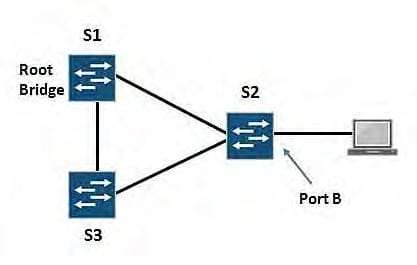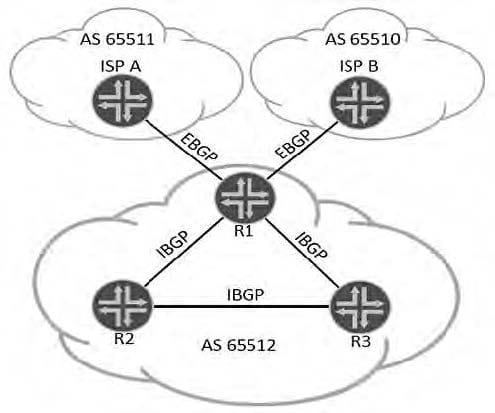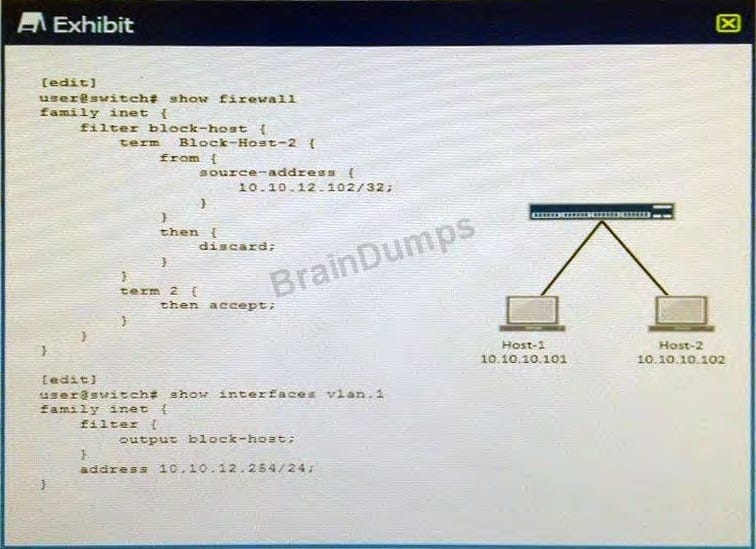Exam Details
Exam Code
:JN0-343Exam Name
:Juniper Networks Certified Internet Specialist (JNCIS-ENT)Certification
:Juniper CertificationsVendor
:JuniperTotal Questions
:563 Q&AsLast Updated
:Jun 04, 2025
Juniper Juniper Certifications JN0-343 Questions & Answers
-
Question 141:
-- Exhibit ?

-- Exhibit -The exhibit shows three switches interconnected using RSTP.
What is the role of Port B?
A. designated
B. root
C. alternate
D. backup
-
Question 142:
Your network design currently consists of a single OSPF backbone area. You are asked to reduce the size of the OSPF link-state database. Which two steps allow you to accomplish this task? (Choose two.)
A. Include LSA export summarization policies on all participating ASBRs.
B. Define multiple backbone areas and interconnect them using virtual links.
C. Define multiple nonbackbone areas and connect them to the backbone area.
D. Include route summarization on the ABRs participating in the configured areas.
-
Question 143:
An OSPF hello packet has been sent, but bidirectional communication has not been established. What is the state of the OSPF adjacency?
A. Exchange
B. Loading
C. Init
D. Down
-
Question 144:
Which three statements are true regarding BGP peers? (Choose three.)
A. BGP peers can reside in the same AS or different ASs.
B. BGP peers on the same router must all use the same peer AS number.
C. External BGP peers have a default TTL value of 1.
D. External BGP peers will always accept the AS path, origin, and next-hop attributes from their neighbors.
E. Internal BGP routers will propagate IBGP learned routes to other IBGP peers by default.
-
Question 145:
A link has failed in your IS-IS network.
Which type of PDU is triggered because of the failure?
A. CSNP PDU
B. PSNP PDU
C. link-state PDU
D. hello PDU
-
Question 146:
Referring to the exhibit, which two statements are true?
[edit protocols bgp]
user@router# show
export policyA;
group isp-peers {
type external;
export policyC;
local-as 7029;
neighbor 192.168.200.1 {
peer-as 709;
}
}
group ibgp-peers {
type internal;
local-address 10.0.0.1;
export policyB;
cluster 1.1.1.1;
neighbor 10.0.0.2 {
export policyD;
}
neighbor 10.0.0.3 { export policyD; neighbor 10.0.0.4; }
A. The policyB routing policy is used by neighbor 10.0.0.4
B. The policyD routing policy is the only policy used by neighbor 10.0.0.2
C. The policyA routing policy takes precedence over all other policies
D. No policy is used for neighbor 10.0.0.4
-
Question 147:
-- Exhibit ?

-- Exhibit -
Referring to the exhibit, you must ensure that on R1 the Internet routes learned from ISP A are more preferred than Internet routes learned from ISP B.
Which statement will allow this behavior?
A. Use a policy to change the local preference value to be higher than 100 on routes learned from ISP B.
B. Use a policy to change the MED value to be higher than 0 on routes learned from ISP A.
C. Use a policy to change the local preference value to be higher than 100 on routes learned from ISP A.
D. Use a policy to change the MED value to be higher than 0 on routes learned from ISP B.
-
Question 148:
Referring to the exhibit, which statement is correct? {master: 0} user@switch> show spanning-tree bridge STP bridge parameters Context ID: 0 Enabled protocol: RSTP Root ID: 8192.50:c5:8d:ae:db:41 Root cost:40000
Root port:ge-0/0/14.0 Hello time:2 seconds Maximum age:40 seconds Forward delay:30 seconds Message age:4 Number of topology changes:1 Time since last topology change: 64 seconds Topology change initiator: ge-0/0/14.0 Topology change last recvd. From: 2c:6b:f5:31:06:0e Local parameters Bridge ID: 32768.50:c5:8d:ae:bd:41 Extended system ID:0 Internal instance ID:0
A. This device is the root bridge.
B. This spanning tree session has timed out.
C. The bridge priority on the root device is set to 8k.
D. The local bridge priority is set to 8k.
-
Question 149:
You are asked to identify a tunneling solution between two remote sites and are considering GRE and IP-IP tunnels to meet the requirement. Which two statements describe the differences between the proposed solutions? (Choose two.)
A. Traffic forwarded through an IP-IP tunnel includes additional overhead when compared to traffic flowing over a GRE tunnel.
B. Traffic forwarded through a GRE tunnel includes additional overhead when compared to traffic flowing over an IP-IP tunnel.
C. IP-IP tunnels support non-IP traffic.
D. GRE tunnels support non-IP traffic.
-
Question 150:
The exhibit shows that Host-1 and Host-2 are attached to the switch and associated with RVI vlan.1. However, traffic sent from Host-1 to Host-2 is not blocked as expected. Why is this problem occurring?

A. Intra-VLAN traffic cannot blocked by a router-based filter.
B. The Block-Host-2 term does not contain the MAC address of Host-2.
C. The block-host filter is applied in the wrong direction of the vlan.1 interface.
D. Inter-VLAN traffic cannot blocked by a router-based filter.
Related Exams:
JN0-102
Internet Associate, Junos(JNCIA-Junos)JN0-104
Junos, Associate (JNCIA-Junos)JN0-105
Junos, Associate (JNCIA-Junos)JN0-1101
Juniper Networks Certified Design Associate (JNCDA)JN0-130
Juniper networks Certified internet specialist.e(jncis-e)JN0-1301
Data Center Design, Specialist (JNCDS-DC)JN0-1302
Data Center Design Specialist (JNCDS-DC)JN0-1331
Security Design, Specialist (JNCDS-SEC)JN0-1332
Security Design, Specialist (JNCDS-SEC)JN0-1361
Service Provider Design Specialist (JNCDS-SP)
Tips on How to Prepare for the Exams
Nowadays, the certification exams become more and more important and required by more and more enterprises when applying for a job. But how to prepare for the exam effectively? How to prepare for the exam in a short time with less efforts? How to get a ideal result and how to find the most reliable resources? Here on Vcedump.com, you will find all the answers. Vcedump.com provide not only Juniper exam questions, answers and explanations but also complete assistance on your exam preparation and certification application. If you are confused on your JN0-343 exam preparations and Juniper certification application, do not hesitate to visit our Vcedump.com to find your solutions here.